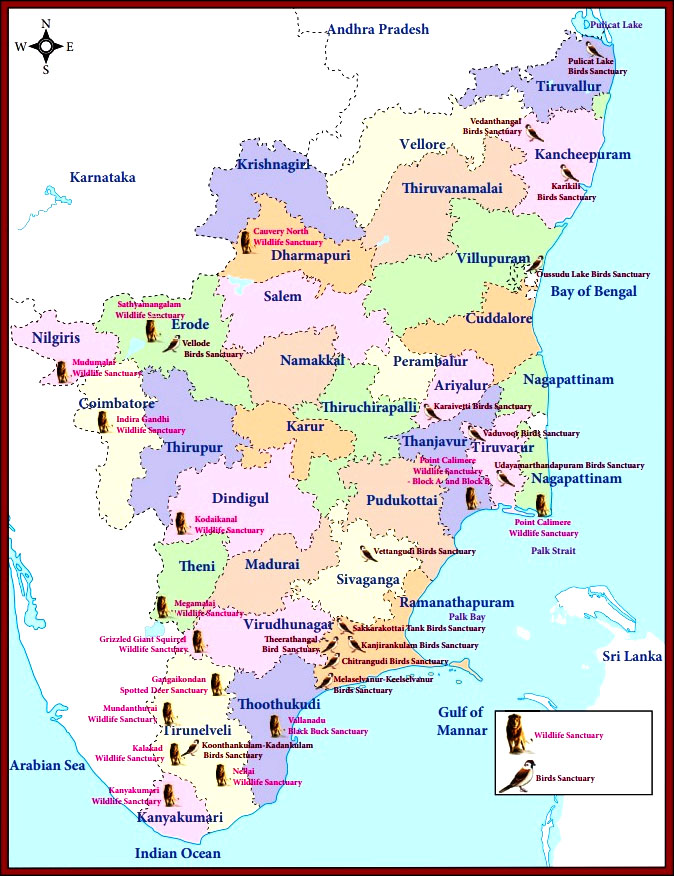Important Facts For Prelims
Mudumalai Tiger Reserve
- 02 Nov 2022
- 6 min read
Why in News?
The Forest Department is coming up with a comprehensive strategy to deal with the spread of the invasive species like Senna spectabilis which continues to spread rapidly in the buffer zone of the Mudumalai Tiger Reserve (MTR) in Nilgiris hill district.
- Invasive weeds such as Senna spectabilis and Lantana camara, as well as wattle, had taken over vast swathes of the Nilgiris.
- The invasive weed has a negative effect on local biodiversity, crowding out native species and limiting food availability for wildlife.
What are the Key Facts about Mudumalai Tiger Reserve?
- About:
- At the tri-junction of three states, namely Karnataka, Kerala, and Tamil Nadu, it is located in the Nilgiris District of Tamil Nadu.
- It has a common boundary with Wayanad Wildlife Sanctuary (Kerala) on the West, Bandipur Tiger Reserve (Karnataka) on the North, together forming a large conservation landscape for flagship species such as Tiger and Asian Elephant.
- Mudumalai tiger reserve is among the 14 Indian tiger reserves that were awarded the Conservation Assured | Tiger Standards (CA|TS) status for effective management of target species.
- The climate of Mudumalai is moderate. It experiences cold weather during the month of December or the beginning of January and hot weather is experienced during the months of March and April.
- Important Flora and Fauna:
- It has tall grasses, commonly referred to as “Elephant Grass”, Bamboo of the giant variety, valuable timber species like Teak, Rosewood, etc.
- There are several species of endemic flora. Such a varied habitat is inhabited by a variety of animals which include tigers, elephants, Indian Gaur, Panther, Sambar, Spotted Deer, Barking Deer, Mouse Deer, Common Langur, Malabar Giant Squirrel, Wild Dog, Mongoose, Jungle Cat, Hyena, among others.
- This reserve has a wide variety of more than 260 species of birds.
- 8% of bird species found in India are recorded in Mudumalai.
What are the Other Tiger Reserves of Tamil Nadu?
- Anamalai:
- About:
- Carved out of the Anamalai hills, the tiger reserve falls within the Western Ghats, which in itself is one of the 25 Global Biodiversity Hotspots.
- The reserve consists of diverse habitats, including tropical forests, shola jungles, bamboo grove and vast grasslands.
- Flora and Fauna:
- Some of the key animals found here apart from the tiger are the Gaur, sloth bear, elephants, pangolin, deer, and over 350 species of birds. Crocodiles can be spotted in the Amaravathy dam reservoir.
- About:
- Kalakkad – Mundanthurai:
- About:
- Popularly known as KMTR, this reserve was created in 1988 by combining the existing and contiguous Kalakkad and Mundanthurai wildlife sanctuaries.
- Kalakkad – Mundanthurai was declared as the first Tiger reserve in Tamil Nadu. It occupies the southern part of the Western Ghats and consists of wet evergreen forests; it is the catchment area of 14 rivers.
- It is also part of the Agasthyamala Biosphere Reserve.
- Agasthyamala Biosphere Reserve is considered one of the five centres of plant diversity and endemism in India by the International Union for Conservation of Nature (IUCN).
- About:
- Flora and Fauna:
- Apart from tigers, the forest is home to Sambar, spotted deer, elephants, leopards, wild dogs, etc., and a large number of bird species, reptiles, etc.
- Sathyamangalam:
- About:
- A tiger reserve since 2013, it forms an important corridor between the Eastern and Western Ghats through the Nilgiris.
- According to the 2019 census, it has an 83-individual tiger population and a 111-individual leopard population.
- About:
- Srivilliputtur Megamalai:
- About:
- The latest tiger reserve in the state, the Srivilliputhur-Megamalai Tiger Reserve (SMTR), was formed in February 2021 by combining the Megamalai and Srivilliputhur wildlife sanctuaries. It lies in the Western Ghats region.
- SMTR is also adjacent to the Kalakkad Mundanthurai reserve.
- Flora and Fauna:
- It’s a blend of tropical evergreen and semi-evergreen forests, dry deciduous and moist mixed deciduous woods, and grassland in this area.
- About:
UPSC Civil Services Examination Previous Year Question:
Q. Which of the following are in Agasthyamala Biosphere Reserve? (2019)
(a) Neyyar, Peppara and Shendurney Wildlife Sanctuaries; and Kalakad Mundanthurai Tiger Reserve
(b) Mudumalai, Sathyamangalam and Wayanad Wildlife Sanctuaries; and Silent Valley National Park
(c) Kaundinya, Gundla Brahmeswaram and Papikonda Wildlife Sanctuaries; and Mukurthi National Park
(d) Kawal and Sri Venkateswara Wildlife Sanctuaries; and Nagarjunasagar-Srisailam Tiger Reserve
Ans: (a)







